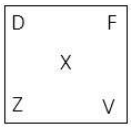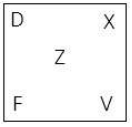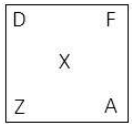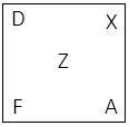Reasoning Practice Question and Answer
8 Q:Directions: Study the following information carefully and answer the questions below.
Eight people- A, B, C, D, W, X, Y and Z are sitting in a circle facing the centre. All eight people are from different place i.e. Okhla, Dwarka, Lajpat Nagar, Chanakyapuri, Saket, Mehrauli, Rohini and Karol Bagh but not necessarily in the same order.
W is sitting third to the left of Y. The person who is from Dwarka is to the immediate right of W and W is not from Okhla. B is sitting fourth to the right of Z. Z is not the neighbour of Y. Neither B nor Z is an immediate neighbour of W. X is from Chanakyapuriand is sitting third to the right of the person from Dwarka. The person from Mehrauli is sitting second to the left of the person from Chanakyapuri. The person from Rohini is sitting second to the left of W. A who is Lajpat Nagar is sitting exactly between X and Z. The person from Saket is sitting second to the right of the person from Lajpat Nagar. C is sitting third to the left of X.
What is A’s position with respect to B?
547 064edd5fe2bbb242750d5d7db
64edd5fe2bbb242750d5d7db- 1Third to the righttrue
- 2Second to the rightfalse
- 3Third to the leftfalse
- 4Second to the leftfalse
- 5Fourth to the rightfalse
- Show AnswerHide Answer
- Workspace
- SingleChoice
Answer : 1. "Third to the right"
Q:Select the odd group of numbers. (NOTE: Operations should be performed on the whole numbers, without breaking down the numbers into its constituent digits. E.g.13 – Operations on 13 such as adding /subtracting /multiplying etc. to 13 can be performed. Breaking down 13 into 1 and 3 and then performing mathematical operations on 1 and 3 is not allowed)
Option
546 06489a49db50f5316a45e0364
6489a49db50f5316a45e0364- 16 – 60false
- 22 – 18true
- 34 – 40false
- 48 – 80false
- Show AnswerHide Answer
- Workspace
- SingleChoice
Answer : 2. "2 – 18"
Q: A – B means ‘A is the mother of B’
A * B means ‘A is the husband of B’
A % B means ‘A is the brother of B’
A $ B means ‘A is the sister of B’
If I * J – K % L $ M * N, then how is I related to N?
546 06489a634b50f5316a45e0aad
6489a634b50f5316a45e0aadA * B means ‘A is the husband of B’
A % B means ‘A is the brother of B’
A $ B means ‘A is the sister of B’
If I * J – K % L $ M * N, then how is I related to N?
- 1Brother-in-lawfalse
- 2Father-in-lawtrue
- 3Brotherfalse
- 4Fatherfalse
- Show AnswerHide Answer
- Workspace
- SingleChoice
Answer : 2. "Father-in-law"
Q:In the following question below are given some statements followed by some conclusions based on those statements. Taking the given statements to be true even if they seem to be at variance from commonly known facts. Read all the conclusions and then decide which of the given conclusion logically follows the given statements.
Statements:
All tomatoes are peas.
Some peas are potatoes.
All potatoes are fruits.
Conclusions:
I. Some tomatoes are potatoes.
II. Some fruits are potatoes.
III. Some peas are fruits.
544 06482ef10bf323e479a9cd029
6482ef10bf323e479a9cd029All tomatoes are peas.
Some peas are potatoes.
All potatoes are fruits.
I. Some tomatoes are potatoes.
II. Some fruits are potatoes.
III. Some peas are fruits.
- 1All conclusions follow.false
- 2Only conclusions I and III follow.false
- 3Only conclusions II and III follow.true
- 4Only conclusions I and II follow.false
- Show AnswerHide Answer
- Workspace
- SingleChoice
Answer : 3. "Only conclusions II and III follow."
Q:Select the number from among the given options that can replace the question mark (?) in the following series.
Question figure.

542 06489855cb50f5316a45d36eb
6489855cb50f5316a45d36eb
- 1false
- 2false
- 3true
- 4false
- Show AnswerHide Answer
- Workspace
- SingleChoice
Answer : 3. "
"

Q:Directions: In the following question assuming the given statements to be true, find which of the conclusions among the given conclusions is/ are definitely true and then give your answers accordingly
Statements:
H ≥ X < R = O > T; Y = F ≥ R > D
Conclusions:
I. H ≥ Y II. Y > H
540 064e871274a145f0934dcd8ab
64e871274a145f0934dcd8abH ≥ X < R = O > T; Y = F ≥ R > D
I. H ≥ Y II. Y > H
- 1Only I is truefalse
- 2Only II is truefalse
- 3Either I or II is truetrue
- 4Both I and II is truefalse
- 5Neither I nor II is truefalse
- Show AnswerHide Answer
- Workspace
- SingleChoice
Answer : 3. "Either I or II is true"
Q: By interchanging the given two signs and numbers which of the following equation will be correct?
× and ÷, 7 and 9
539 06486f53c23e51f477717a24b
6486f53c23e51f477717a24b× and ÷, 7 and 9
- 19 – 7 × 2 + 6 ÷ 3 = 11false
- 29 + 4 × 3 – 7 ÷ 1 = 40false
- 38 × 3 ÷ 6 + 9 – 7 = 14true
- 49 × 3 + 4 ÷ 2 – 7 = 18false
- Show AnswerHide Answer
- Workspace
- SingleChoice
Answer : 3. "8 × 3 ÷ 6 + 9 – 7 = 14"
Q: Directions: In the following question assuming the given statements to be true, find which conclusion among the given conclusions is/are definitely true and then give your answers accordingly
Statement:
R ≥ T = Q < M; S ≥ R
Conclusions:
I. M < R
II. S ≥ Q
536 064dcb537ad4e6a1a0b61d156
64dcb537ad4e6a1a0b61d156- 1Only I is Truefalse
- 2Only II is Truetrue
- 3Either I or II is truefalse
- 4Both conclusions I and II are Truefalse
- 5None is Truefalse
- Show AnswerHide Answer
- Workspace
- SingleChoice




